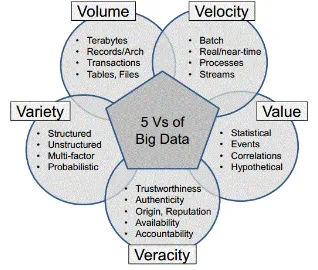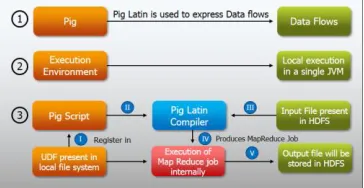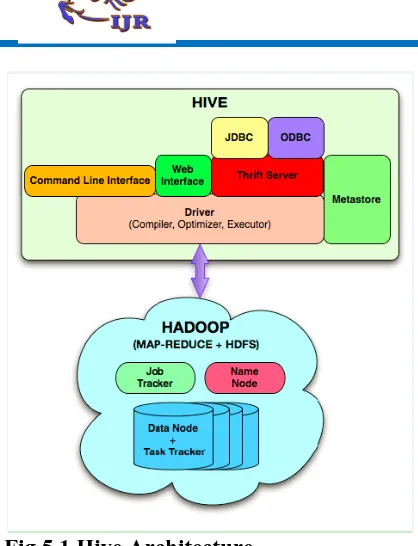Available online: https://edupediapublications.org/journals/index.php/IJR/ P a g e | 1562
A Detail Study on Big Data Analytics Using Hadoop Technologies
1
Sowmya Koneru
1Assistant professor, Dhanekula Institute of Engineering and Technology, Ganguru, Vijayawada,
Andhra Pradesh, India konerusowmya@gmail.com
ABSTRACT
Big data is a term that describes the large volume of data. That contains data in the form of both structured and un-structured data. These data sets are very large and complex so that it becomes difficult to process using traditional data processing applications. Big data is difficult to work with using most relational database management systems and desktop statistics and visualization packages, requiring instead "massively parallel software running on tens, hundreds, or even thousands of servers". The technologies used in Hadoop by big data application to handle the massive data are Hdfs, Map Reduce, Pig, Apache Hive, Hbase and Spark. These technologies handle massive amount of data in KB, MB, GB, TB, PB, EB, ZB, YB and BB.
Keywords: Apache hive, Big Data, Hadoop, Hbase, Map Reduce, Pig, Spark.
I. INTRODUCTION
Big Data: The whole world has a tendency to
produce 2.5 quintillion bytes of data — so much that 90th of the data within the world
these days has been created within the last four years alone. This much amount of data comes from everywhere: sensors used to gather climate data, posts to social media sites, digital pictures and videos, purchase transaction records, and cell phone GPS signals to call some. This huge amount of the data is understood as “Big data”. Big data is a nonsensicality, or catch-phrase, utilizes to describe a {huge an enormous a vast a colossal} volume of both structured and unstructured data that's so huge that it’s sophisticated to process using traditional database and software system techniques. In most enterprise scenarios the data is too massive or it moves too quick or it exceeds current process capability. Big data has the potential to facilitate organizations to enhance operations and build faster, more intelligent choices. Big Data, now a day this term becomes common in IT industries. As there's a large amount {of data of knowledge of
information} lies within the trade however there is nothing before massive data comes into image. The need of massive data generated from the big corporations like Facebook, Yahoo, Google, YouTube etc. for the purpose of research of enormous quantity of data that is in unstructured type or maybe in structured type. Google contains the large quantity of data. So; there is the requirement of massive Data Analytics to process the complicated and large data. So there are several type of information round the world like Structured, Semi-structured, Un-structured here I mention the different presence of data that are within the means like:
Five V’s (volume, velocity, veracity, variety,
value):
Available online: https://edupediapublications.org/journals/index.php/IJR/ P a g e | 1563 On Facebook alone we send ten billion
messages per day, click the “like” button 4.5billion times and transfer 350 million newphotos each and every day. If we take all thedata generated within the world between thestart of your time and 2008, the same amount
ofdata{of|information|of|knowledge}can presently be generated each minute. Thismore and more makes data sets large to storeand analyze using traditional databasetechnology. With big data technologywe can currently store and use these data setswith the assistance of distributed systems,where elements of the data are keep in several
locations and brought along by
softwaresystem.
2. VELOCITY: Velocity refers to the speedat that new data is generated and the speedat that data moves around. Just suppose ofsocial media messages going viral in seconds,the speed at which credit cardtransactions are checked fordishonorable activities, or the milliseconds ittakes trading systems to analyze social medianetworks to choose up signals thattrigger selections to shop for or sell shares.Big data technology permits for United Statescurrently to analyze the data whereas it’s beinggenerated, without ever putting it intodatabases.
3. VERACITY: Veracity refers to the messinessor trustiness of the data. With many formsof huge data, quality and accuracy areless manageable (just suppose of Twitter postswith hash tags, abbreviations, typos andcolloquial speech as well becausethe reliableness and accuracy ofcontent) however huge data and analyticstechnology currently permits United States tofigure with these style of data. The volumesoften build up for the shortage of quality oraccuracy.
4. VARIETY: Variety refers to the totallydifferent sorts of data we are ableto currently use. In the past we targeted
onstructured data that neatly fits into tables orrelational databases, such as financial data (e.g.sales by product or region). In fact, 80% of theworld’s data is currently unstructured, and
therefore can’t simply be place into tables(think of photos, video sequences or social media updates). With big data technology wecan currently harness differed varieties ofdata (structured and unstructured) together withmessages, social media conversations, photos,sensor data, video or voice recordings and bringthem in conjunction with more traditional,structured data.
5. VALUE: Value! It is all well and goodhaving access to huge data however unless weare able to flip it into price it’s useless. Soyou will safely argue that 'value' is that the mostvital V of massive data. It is important so thatcompanies build a business case forany conceive to collect and leverage huge data.It is very easy to be the thrill trap andcommence huge data initiative while not atransparent understandingof prices and advantages
Fig. 1.1 Parameters of Big Data
II. HADOOP
Available online: https://edupediapublications.org/journals/index.php/IJR/ P a g e | 1564 computation and storage. Rather than suppose
hardware to deliver highavailability, itself is designed to detect and handle failures at the applying layer, so delivering a highly-available service on the top of a cluster (multiple nodes) of computers, each of that might be susceptible to failures. Hadoop is commonly used for distributed batch index building; it's fascinating to optimize the index capability in close to real time. Hadoop
provides components for storage and analysis for massive scale process. The core of Apache Hadoop consists of a storage part, known as Hadoop Distributed file system (HDFS), and the processing part is called Map Reduce.
Fig. 2.1 Hadoop System
III.MAP REDUCE
Hadoop Map Reduce is a software system framework for simply writing applications that process large amounts of data (multi-terabyte data-sets) in-parallel on large clusters (thousands of nodes)
of goods hardware in an exceedingly reliable, fault-tolerant manner. A Map Reduce jobtypically splits the input data-set into freelance chunks that are processed by the map tasks ina fully parallel manner. The framework sorts the outputs of the maps, which are then input tothe reduce tasks. Typically, both the input and the output of the work are keep in anexceedingly file-system. The framework takes care of scheduling tasks, monitoring them andre-executes the failing tasks.
Fig 3.1 Map Reduce Operations
The Map Reduce framework consists of a single master Job tracker and one slave Task tracker per cluster-node. The master is responsible for scheduling the jobs' element tasks on the slaves, monitoring them and re-executing the unsuccessful tasks. The slaves execute the tasks as directed by the master.
Fig 3.2 Map Reduce Data Flow with A Single
Reduce Task
3.1 INPUTS AND OUTPUTS:
The Map Reduce framework operates completely on <key, value> pairs, that is, the framework views the input to the job as a group of <key, value> pairs and produces a set of <key, value> pairs as the output of the work, conceivably of different varieties. The key and value categories have to be serializable by the framework and hence got to
implement the Writable interface.
Available online: https://edupediapublications.org/journals/index.php/IJR/ P a g e | 1565 combine -><k2, v2> -> reduce -><k3, v3>
(output).
3.2 EXAMPLE: WORD COUNT V1.0
• Before we jump into the details, lets walk through an example Map reduce application to get a flavor for the way they work.
• Word Count is the simple application that counts the number of occurrences of each word in an exceedingly given input set.
• This works with a local-standalone, pseudodistributed or fully-distributed Hadoop installation (Single Node Setup).
Fig 3.3 Word count java code
3.3 USAGE:
Assuming HADOOP_HOME is the root of the installation and HADOOP_VERSION.
Hadoop version installed, compile WordCount.java and create a jar:
$ mkdir wordcount_classes $ javac -classpath
${HADOOP_HOME}/hadoop-
${HADOOP_VERSION}-core.jar –d
wordcount_classes WordCount.java
$ jar -cvf /usr/joe/wordcount.jar –C wordcount_classes/ .
ASSUMING THAT:
• /usr/joe/wordcount/input - input directory in HDFS
• /usr/joe/wordcount/output - output directory in HDFS
SAMPLE TEXT-FILES AS INPUT:
$ bin/hadoop dfs -ls /usr/joe/wordcount/input/ /usr/joe/wordcount/input/file01
/usr/joe/wordcount/input/file02
$ bin/hadoop dfs –cat
/usr/joe/wordcount/input/file01 Hello World Bye World (input file text)
$ bin/hadoop dfs –cat
/usr/joe/wordcount/input/file02 Hello Hadoop Goodbye Hadoop
RUN THE APPLICATION:
$ bin/hadoop jar /usr/joe/wordcount.jar org.myorg.WordCount
/usr/joe/wordcount/input /usr/joe/wordcount/output
OUTPUT:
$ bin/hadoop dfs –cat
/usr/joe/wordcount/output/part-00000
Bye 1 Goodbye 1 Hadoop 2 Hello 2 World 2
IV. PIG
Pig was initially developed at Yahoo! to allow individuals using Apache Hadoop to focus a lot of on analyzing massive data sets and pay less time having to put in writing mapper and reducer programs. Like actual pigs, who eat nearly something, the Pig programming language is meant to handle any reasonably data—hence the name! Pig is made up of two components: the first component is that the language itself, which is known as Pig Latin (yes, people naming various Hadoop projects do tend to have a way of humor related to their naming conventions), and the second could be a runtime environment wherever Pig Latin programs are executed. Think of the link between a Java Virtual Machine (JVM) and a Java application. In this section, we’ll just refer to the total entity
Available online: https://edupediapublications.org/journals/index.php/IJR/ P a g e | 1566 Let’s first look at the programming
language itself so you can see how it’s significantly easier
than having to write mapper and reducer programs.
1. The first step in an exceedingly Pig program is to LOAD the data you wish to control from
HDFS.
2. Then you run the data through a group oftransformations (which, under the covers, aretranslated into a set of mapper and reducertasks).
3. Finally, you DUMP the data to the screen oryou STORE the results in a file somewhere.
Fig 4.1 Apache Pig Operations
V. HIVE
Hive, allows SQL developers to write Hive query language (HQL) statements that are similar to standard SQL statements; now you must remember that HQL is proscribed in the commands it understands, but it is still pretty useful. HQL statements are broken down by the Hive service into Map reduce jobs and executed across a Hadoop cluster. For anyone with a SQL or relational database background, this section will look very familiar to you. As with any database management system (DBMS), you can run your Hive queries in many ways. You can run them from a program
line interface (known because the Hive shell), from a Java database connectivity (JDBC) or Open
Database connectivity (ODBC) application leveraging the Hive JDBC/ODBC drivers, or from what is called a Hive Thrift consumer.
The Hive Thrift Client is a lot of like every database consumer that gets installed on a user’s consumer machine (or in an exceedingly middle tier of a three-tier
architecture): it communicates with the Hive services running on the server. Hive looks terribly abundant like traditional database code with SQL access. However, because Hive is primarily based on Hadoop and Map reduce operations, there are many key variations. The first is that Hadoop is
meant for long successive scans, and because Hive is predicated on Hadoop, you can expect queries to possess a really high latency (many minutes). This means that Hive wouldn’t be applicable for applications that require in no time response times, as you would expect with a database like DB2. Finally, Hive is read-based and therefore not acceptable for dealings processing that usually i
nvolves a high percentage of write operations Currently, there are four file formats supported
in Hive, which are TEXTFILE,
SEQUENCEFILE, ORC and RCFILE. Other features of Hive include:
• Indexing to provide acceleration, index type as well as compaction and image index as of 0.10, more index varieties are planned.
Available online: https://edupediapublications.org/journals/index.php/IJR/ P a g e | 1567
Fig 5.1 Hive Architecture
VI. HBASE
HBase is a column-oriented database management system that runs on top of HDFS. It is compatible for sparse data sets, which are common in several huge data use cases. Unlike relational database systems, HBase does not support a structured command language like SQL; actually, HBase isn’t a relational data store at all. HBase applications are written in Java much like a typical Map reduce application. For example, if the table is storing diagnostic logs from servers in your environment, where each row would possibly be a log record, a typical column in such a table would be the timestamp of when the log record was written, or perhaps the server name wherever the record
originated. In fact, HBase allows for several attributes to be classified together into what are called column families, such that the weather of a column family is all keep together. This is different from a roworiented on-line database, where all the columns of a given row are stored together. With HBase you must predefine the table schema and
specify the column families. However, it’s very
versatile in that new columns are often additional to families at any time, makingthe schema flexible and thus ready to adapt todynamic application needs. Just asHDFS includes a NameNode and slave nodes,and MapReduce has JobTracker andTaskTracker slaves, HBase is built onsimilar ideas. In HBase a master node managesthe cluster and region servers store portions ofthe tables and perform the work on the data.
Fig. 6.1 Hbase Architecture
VII. SPARK
Apache Spark is a lightning-fast
clustercomputing technology, designed for
fastcomputation. It is supported
HadoopMapReduce and it extends the MapReducemodel to efficiently use it for more formsof computations, which includes interactivequeries and stream process. The main feature of
Available online: https://edupediapublications.org/journals/index.php/IJR/ P a g e | 1568 7.1 FEATURES OF APACHE SPARK:
Apache Spark has following features.
Speed − Spark helps to run an application inHadoop cluster, up to 100 times quicker in memory, and 10 times quicker when running ondisk. This is possible by reducing variety of read/write operations to disk. It stores theintermediate processing data in memory.
Supports multiple languages − Spark providesbuilt-in Apis in Java, Scala, or Python.Therefore, you can write applications inseveral languages. Spark comes up with 80high-level operators for interactive querying.
Advanced Analytics − Spark not
onlysupports ‘Map’ and ‘reduce’. It also supportsSQL queries, Streaming data, Machine learning(ML), and Graph algorithms. 7.2 SPARK BUILT ON HADOOP:
The following diagram shows three ways
ofhow Spark can be built with
Hadoopcomponents.
Fig.7.1 Spark Architecture
There are three ways of Spark deployment as explained below.
Standalone− Spark is a
Standalonedeployment suggests that Spark occupies theplace on high of HDFS (Hadoop DistributedFile System) and house is allocated for HDFS,explicitly. Here, Spark and MapReduce will runside by side to cover all spark jobs on cluster.
Hadoop Yarn− Hadoop Yarndeployment suggests that, simply, spark runs onYarn without any pre-installation or rootaccess needed. It helps to integrate Spark intoHadoop ecosystem or Hadoop stack. Itallows alternative elements to run on top ofstack.
Spark In Mapreduce (SIMR)− Spark inMapReduce is used to launch sparkjob additionally to standalone deployment. WithSIMR, user can begin Spark and uses itsshell without any administrative access.7.3Components of Spark.
7.3COMPONENETS OF SPARK:
The following illustration depicts the differentcomponents of Spark:
Fig.7.2 Spark Core Components
7.3.1 APACHE SPARK CORE
Spark Core is the underlying general executionengine for spark platform that all other functionality is built upon. It provides In-Memory computing and referencing datasets inexternal storage systems.
7.3.2 SPARK SQL
Spark SQL is a component on top of SparkCore that introduces a new data abstractioncalled Schema RDD, which provides supportfor structured and semi-structured data.
7.3.3 SPARK STREAMING
Available online: https://edupediapublications.org/journals/index.php/IJR/ P a g e | 1569
7.3.4 MLLIB (MACHINE
LEARNINGLIBRARY)
MLlib is a distributed machine
learningframework above Spark because of
thedistributed memory-based Spark
architecture.It is, according to benchmarks, done by theMLlib developers against the
Alternating LeastSquares (ALS)
implementations. Spark MLlibis nine times as fast as the Hadoop disk-basedversion of Apache Mahout (before Mahoutgained a Spark interface).
7.3.5 GRAPHX
GraphX is a distributed
graph-processingframework on top of Spark. It provides an APIfor expressing graph computation that canmodel the user-defined graphs by using Preglabstraction API. It also provides an optimizedruntime for this abstraction.
VIII. CONCLUSIONS
Hadoop and the MapReduce
programmingparadigm have already got
aconsiderable base within the
bioinformaticscommunity, especially in the field of nextgenerationsequencing analysis, and such use isincreasing. This is as a result of the costeffectivenessof Hadoop-based analysis on
commodity Linux clusters, and in the cloud viadata transferto cloud vendors who have implemented
Hadoop/HBase; and due to the
effectivenessand ease-of-use of the MapReduce technique in
parallelization of the many data
analysisalgorithms.
IX. REFERENCES:
[1] Vibhavari Chavan etal,
/(IJCSIT)International Journal of Computer Science andInformation Technologies, Vol. 5 (6)
[2] Yuri Demchenko “The Big
DataArchitecture Framework (BDAF)”
Outcome of
the Brainstorming Session at the University ofAmsterdam 17 July 2013.
[3] Big Data, Data Mining, and
MachineLearning: Value Creation for Business Leadersand Practitioners by Jared Dean
[4] D.Talia, “Clouds for scalable big dataanalytics,” Computer, vol. 46, no. 5, Article ID6515548, pp. 98–101, 2013.
[5] D. E. O'Leary, “Artificial intelligenceand big data,” IEEE Intelligent Systems, vol.28, no. 2, pp. 96–99, 2013.
[6] The Hadoop Distributed File
System,Konstantin Shvachko, Hairong Kuang, SanjayRadia, Robert Chansler Yahoo! Sunnyvale,California USA 2010.
[7] Hadoop: The Definitive Guide by TomWhite
[8] Dean, J. and Ghemawat, S.,“MapReduce: a flexible data processing tool”,ACM 2010 [9] Pig - Apache Software Foundation projecthome page. http://pig.apache.org/
[10] Hive - Apache Software
Foundationproject home
page.http://hadoop.apache.org/hive/
[11] HBase - Apache Software
Foundationproject home
page.http://hadoop.apache.org/hbase/
[12] Hadoop - Apache Software
Foundationproject home page.
http://hadoop.apache.org/
[13] Cloudera recommendations
onHadoop/HBasehttp://www.cloudera.com/bl og/2010/08/hadoophbase-capacity-planning/ [14]Hbasehttp://www01.ibm.com/software/dat a/ infosphere/hadoop/hbase


